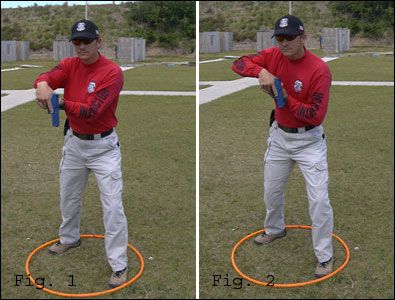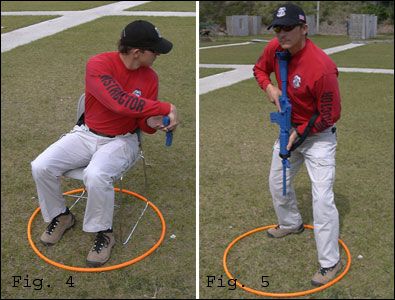For the past 12 years, the NRA’s Law Enforcement Activities Division has taught the concept of the Safety Circle in Firearms Instructor Development courses offered nationwide. Throughout the past decade, I’ve seen the concept renamed and re-taught at many training conferences and courses, but occasionally I still find that officers and agencies are unfamiliar with it.
What is the Safety Circle?
The Safety Circle was first introduced by my friend and mentor Clive Shepherd as he developed some of the NRA LEAD’s training courses. Clive’s intent in teaching the concept was for officers to have a place to point the muzzle when a downrange direction did not necessarily exist, or when working in and around other people who did not need to be shot or muzzled.
On the range, we usually think that the targets or the berm are safe places to point the muzzle. Clive recognized that on the street, downrange may not be so easy to recognize and innocent citizens and other officers may well occupy that space. The Safety Circle reflects the idea that there may not be a recognizable “safe place” to point the muzzle. Therefore, Clive taught the concept of finding the safest place to point the muzzle when the firearm is drawn.
In using and understanding the Safety Circle, you must first recognize that it is not a technique, a movement, or spin of some kind. Rather, it is a concept that utilizes three basic principles:
1. The Safety Circle is a geographical location that represents the safest direction to point a firearm in a real world or street environment. The Safety Circle is the circular area about a yard around where the officer is standing or sitting at any given time. It would be what we describe as our “personal space.” If we extended our hands and imagined that we were standing in the center of a tube or column, the Safety Circle would represent the place where that tube would touch the ground. This circle moves with us and goes everywhere we go. I often use a hoola-hoop on the ground to demonstrate where the circle is and I demonstrate that it wraps completely around the body.
 The handgun can be pushed away from the body in a near ready or pulled in closed to body as in the “sul position.” |
2. The muzzle of the firearm is pointed directly into the Safety Circle while the eyes search for targets in a 360 degree environment. Based on our cardinal safety rules, the muzzle should always be pointed where there is no possibility of muzzling others unless we intend to shoot them. On the street, where there are citizens and others officers, the Safety Circle becomes that default location where the muzzle can be pointed without endangering others.
3. The drawn firearm is held parallel to the body. The distance that the shooter holds the gun from the body is not important, but the fact that the gun is held parallel to the body gives muscle tension and causes the shooter to be always cognizant of the muzzle direction. This muscle tension also keeps the gun from rising into targets unintentionally during quick pivots and turns in a 360 degree environment. Depending on the officer’s grip technique, he or she may relax a portion of the grip to achieve this. The “sul technique” would be an example of this. When the officer does decide to shoot, the gun rotates up onto the target as it is extended into the firing position and the officer achieves his or her final firing grip.
 The three principles of the Safety Circle remain consistent regardless of the firearm used or the position of the officer. |
Training with the Safety Circle
Once the above three principles are understood, officers can use the Safety Circle concept to have their firearms drawn safely in a 360 degree environment without needlessly muzzling other officers or citizens. Once this foundation is laid, there are endless options in training or tactics that can now be considered using the Safety Circle.
For instance, shooters can pivot and turn into a threat without needlessly muzzling other officers around them on a firing line. They can also return to the Safety Circle after firing and turn their body along with their heads as they search and scan for other threats. Officers can move independently or in groups in a stack, a line, or a cell formation (active shooter response), and all officers using the Safety Circle will not be needlessly muzzling each other.
The Safety Circle can be used with any firearm so long as the three principles are used. Whether the gun is a handgun, a sub-gun, patrol rifle, or shotgun, the principles remain the same to keep the muzzle controlled. If the Safety Circle becomes the default carry position, it also becomes a means of carrying the gun in a close relaxed position rather than extending it and wasting energy while seeking for a potential target.
The Safety Circle does not replace a solid directed ready position — in fact, if the officer is giving a verbal challenge to a visible suspect, he or she should probably have the gun extended out in a solid ready position with a firing grip in anticipation of the possible need to use deadly force. But if the officer does not specifically know where the threat may come from, then the Safety Circle allows him or her to keep the weapon drawn and still pointed safely while searching and moving as he needs.
As I write the articles that make up this column, I will be describing firearms training that often forces the officers to work in a 360 degree environment with other officers just like they do on the street. The Safety Circle is the foundational concept that enables this type of training. For officers and trainers who seek to make their training more realistic, the Safety Circle will allow safer more realistic gun-handling in a real world environment.



